Translated5
- 格式:doc
- 大小:104.00 KB
- 文档页数:16
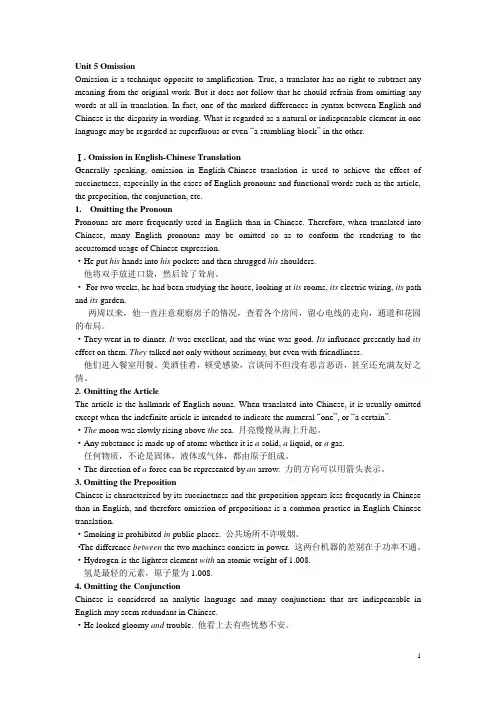
Unit 5 OmissionOmission is a technique opposite to amplification. True, a translator has no right to subtract any meaning from the original work. But it does not follow that he should refrain from omitting any words at all in translation. In fact, one of the marked differences in syntax between English and Chinese is the disparity in wording. What is regarded as a natural or indispensable element in one language may be regarded as superfluous or even “a stumbling block” in the other.Ⅰ. Omission in English-Chinese TranslationGenerally speaking, omission in English-Chinese translation is used to achieve the effect of succinctness, especially in the cases of English pronouns and functional words such as the article, the preposition, the conjunction, etc.1.Omitting the PronounPronouns are more frequently used in English than in Chinese. Therefore, when translated into Chinese, many English pronouns may be omitted so as to conform the rendering to the accustomed usage of Chinese expression.·He put his hands into his pockets and then shrugged his shoulders.他将双手放进口袋,然后耸了耸肩。

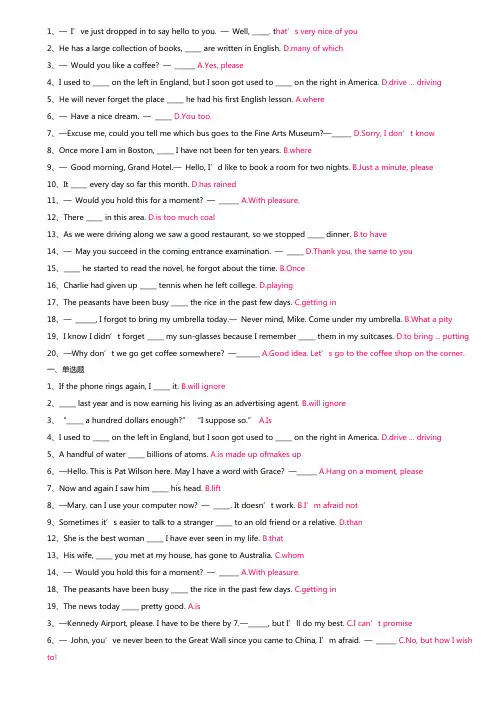
1、—I’ve just dropped in to say hello to you. —Well, _____. t hat’s very nice of you2、He has a large collection of books, _____ are written in English. D.many of which3、—Would you like a coffee? —______ A.Yes, please4、I used to _____ on the left in England, but I soon got used to _____ on the right in America. D.drive ... driving5、He will never forget the place _____ he had his first English lesson. A.where6、—Have a nice dream. —_____ D.You too.7、—Excuse me, could you tell me which bus goes to the Fine Arts Museum?—______ D.Sorry, I don’t know8、Once more I am in Boston, _____ I have not been for ten years. B.where9、—Good morning, Grand Hotel.—Hello, I’d like to book a room for two nights. B.Just a minute, please10、It _____ every day so far this month. D.has rained11、—Would you hold this for a moment? —______ A.With pleasure.12、There _____ in this area. D.is too much coal13、As we were driving along we saw a good restaurant, so we stopped _____ dinner. B.to have14、—May you succeed in the coming entrance examination. —_____ D.Thank you, the same to you15、_____ he started to read the novel, he forgot about the time. B.Once16、Charlie had given up _____ tennis when he left college. D.playing17、The peasants have been busy _____ the rice in the past few days. C.getting in18、—______, I forgot to bring my umbrella today.—Never mind, Mike. Come under my umbrella. B.What a pity19、I know I didn’t forget _____ my sun-glasses because I remember _____ them in my suitcases. D.to bring ... putting20、—Why don’t we go get coffee somewhere? —_______ A.Good idea. Let’s go to the coffee shop on the corner.一、单选题1、If the phone rings again, I _____ it. B.will ignore2、_____ last year and is now earning his living as an advertising agent. B.will ignore3、“_____ a hundred dollars enough?”“I suppose so.”A.Is4、I used to _____ on the left in England, but I soon got used to _____ on the right in America. D.drive ... driving5、A handful of water _____ billions of atoms. A.is made up ofmakes up6、—Hello. This is Pat Wilson here. May I have a word with Grace? —______ A.Hang on a moment, please7、Now and again I saw him _____ his head. B.lift8、—Mary, can I use your computer now? —_____. It doesn’t work. B.I’m afraid not9、Sometimes it’s easier to talk to a stranger _____ to an old friend or a relative. D.than12、She is the best woman _____ I have ever seen in my life. B.that13、His wife, _____ you met at my house, has gone to Australia. C.whom14、—Would you hold this for a moment? —______ A.With pleasure.18、The peasants have been busy _____ the rice in the past few days. C.getting in19、The news today _____ pretty good. A.is3、—Kennedy Airport, please. I have to be there by 7.—______, but I’ll do my best. C.I can’t promise6、—John, you’ve never been to the Great Wall since you came to China, I’m afraid. —______ C.No, but how I wish to!8、He won’t go on doing the job _____ he gets his salary raised. C.unless9、—Have a nice dream. —_____ D.You too.12、They _____ so that we wouldn’t recognize them. D.were disguised13、—Can you help me? —_____ C.Sure, What is it?15、My pictures _____ until next week. D.won’t be developed16、Our children _____ more TV now.C.are watching17、You’d better have your TV set _____ .B.repaired18、The number of the students in the class _____ limited to thirty. C.is19、Is there any reason _____ you should lie ? A.why20、I know I didn’t forget _____ my sun-glasses because I remember _____ them in my suitcases. D.to bring ... putting一、单选题1、If the phone rings again, I _____ it. B.will ignore2、A handful of water _____ billions of atoms. A.is made up ofmakes up3、Now and again I saw him _____ his head. B.lift4、He won’t go on doing the job _____ he gets his salary raised. C.unless5、Tom, with a dog, _____ standing on the floor upstairs yesterday. A.was6、—Let me introduce myself. I’m Albert. —______. C.Pleased to meet you7、— Good morning, Grand Hotel.—Hello, I’d like to book a room for two nights. B.Just a minute, please.8、They _____ so that we wouldn’t recognize them. D.were disguised9、She is the best woman _____ I have ever seen in my life. B.that10、— Can you help me? — _____ C.Sure, What is it?11、_____ we had enough time, we walked to the exhibition. C.Since12、I still remember the winter _____ we went to Harbin to see the ice-lamp. D.when13、There _____ in this area. D.is too much coal14、Our children _____ more TV now. C.are watching15、—I’m sorry I’m late. I got caught in traffic. —_____ C.Oh, that’s OK. I’ve only been here for a little while.16、As we were driving along we saw a good restaurant, so we stopped _____ dinner. B.to have17、—What’s the matter with you? — _____ B.I feel rather unwell.18、The peasants have been busy _____ the rice in the past few days. C.getting in19、— ______, I forgot to bring my umbrella today.— Never mind, Mike. Come under my umbrella. B.What a pity20、The two brothers look so alike _____ no one could tell them apart. B.that一、单选题1、Please stop __________. It cannot help the situation. B.shouting2、Hardly _________ home when it began to rain. A.had I got3、I’d rather stay at home than ________ a walk. C.take4、If the man _________ succeed, he must work as hard as he can. B.is to5、— What subjects are you studying? -- _____. C.I’m studying philosophy6、The big man has always been eating on the go, _______ he has got stomachache. A.so7、She was convicted _______ murder. C.of8、Let me ___________ the case carefully before I draw a conclusion. B.look into9、The bedroom needs __________. A.decorating10、—Let’s take a walk. -- _____. A.Yes, let’s11、Not always _________ they want (to). B.can people do what12、The sun heats the earth, _________ is very important to living things. C.which13、All the team members tried their best. We lost the game, _________. A.however14、Sadam ________ for 25 years. B.was married15、He is the man _________ dog bit me. D.whose16、She _______ her success to hard word and strong will. C.owes17、--- Could you tell me where Mr. Lake is? --- _____. B.At the office18、Ancient Greece is the __________ of western civilization. A.origin19、— I think the Internet is very helpful.--- _____. A.Yes, so do I20、I have lived here _________ 1997. B.since一、单选题1、-What do you think of Chinese food? -_____. A.I think it’s wonderful2、-I’m afraid I must go now. -_____. B.Well, thanks for coming.3、He is a popular movie star. His popularity _____ in the high attendance at all his movies. C.is reflected4、His book is reported _____ into several foreign languages already. D.to have been translated5、---- I do apologize for knocking you down. ---- _____. C.Don’t worry about it.6、_____ in the leg, the soldier was sent to hospital at once. A.Seriously injured7、“The ceremony has already started.” “Look! The flag _____ now.” A.is being raised8、When Mr. Smith failed _____ us, we left without him. A.to meet9、_____ from what he said, the scientist must have met a lot of difficulties in his work. C.Being judged10、—We’ll have a party on Sunday. Will you join us? —___________ B.Yes, I’d love to.11、_____ in the open air has given you a good color. C.Working12、We have missed the last bus. It means _____ to walk over the mountain. B.having13、When mother entered the bed room, little Shelly pretended _____ asleep. D.to have fallen14、I don’t regret _____ her what I thought, even if it _____ her. C.having t old ... hurt15、I don’t want you _____ your brains about such problems. C.to be always bothering16、The world’s supplies of copper _____. D.are being gradually exhausted17、_____ what she would do, she didn’t say anything. C.Asked18、She is _____ talking when I am watching TV. A.always19、— Do you think I could borrow your calculator? — __________ A.Yes, help yourself.20、We must have the work _____ before next Friday. B.finished。
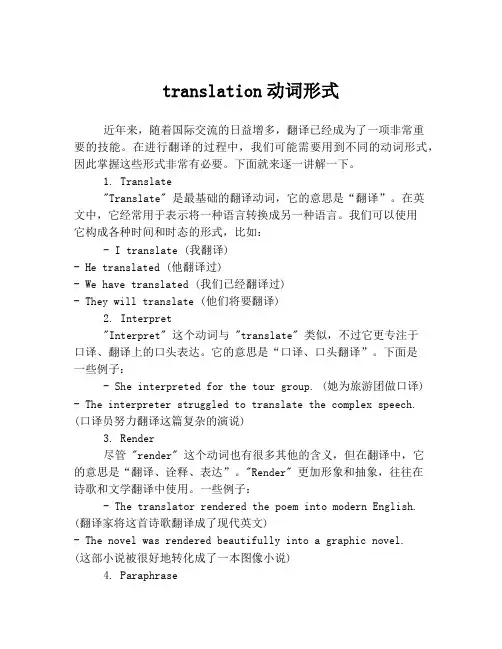
translation动词形式近年来,随着国际交流的日益增多,翻译已经成为了一项非常重要的技能。
在进行翻译的过程中,我们可能需要用到不同的动词形式,因此掌握这些形式非常有必要。
下面就来逐一讲解一下。
1. Translate"Translate" 是最基础的翻译动词,它的意思是“翻译”。
在英文中,它经常用于表示将一种语言转换成另一种语言。
我们可以使用它构成各种时间和时态的形式,比如:- I translate (我翻译)- He translated (他翻译过)- We have translated (我们已经翻译过)- They will translate (他们将要翻译)2. Interpret"Interpret" 这个动词与 "translate" 类似,不过它更专注于口译、翻译上的口头表达。
它的意思是“口译、口头翻译”。
下面是一些例子:- She interpreted for the tour group. (她为旅游团做口译) - The interpreter struggled to translate the complex speech. (口译员努力翻译这篇复杂的演说)3. Render尽管 "render" 这个动词也有很多其他的含义,但在翻译中,它的意思是“翻译、诠释、表达”。
"Render" 更加形象和抽象,往往在诗歌和文学翻译中使用。
一些例子:- The translator rendered the poem into modern English. (翻译家将这首诗歌翻译成了现代英文)- The novel was rendered beautifully into a graphic novel.(这部小说被很好地转化成了一本图像小说)4. Paraphrase"Paraphrase" 的意思是“释义、改写”。
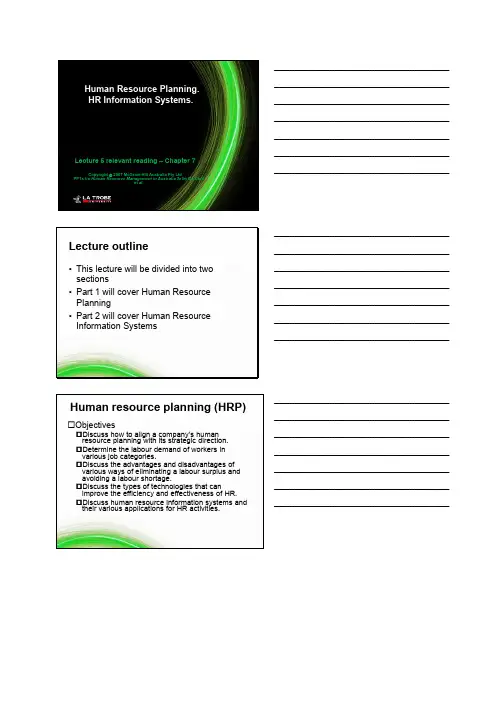
Human Resource Planning.HR Information Systems.Lecture 5 relevant reading –Chapter 7Copyright 2007 McGraw-Hill Australia Pty LtdPPTs t/a Human Resource Management in Australia 3e by De Cieriet al.___________________________________ ___________________________________ ___________________________________ ___________________________________ ___________________________________ ___________________________________Lecture outline•This lecture will be divided into two sections•Part 1 will cover Human Resource Planning•Part 2 will cover Human Resource Information Systems ___________________________________ ___________________________________ ___________________________________ ___________________________________ ___________________________________ ___________________________________ ___________________________________Human resource planning (HRP) ObjectivesDiscuss how to align a company’s humanresource planning with its strategic direction.Determine the labour demand of workers invarious job categories.Discuss the advantages and disadvantages ofvarious ways of eliminating a labour surplus andavoiding a labour shortage.Discuss the types of technologies that canimprove the efficiency and effectiveness of HR.Discuss human resource information systems and their various applications for HR activities.___________________________________ ___________________________________ ___________________________________ ___________________________________ ___________________________________ ___________________________________ ___________________________________What is HRP?•Bridge between strategic HRM and HR functions•A move from STATIC (here, now) to DYNAMIC (predictions of future changes)•Attempt to match future human resources to future needs of organisation •Involves forecasting –risks ___________________________________ ___________________________________ ___________________________________ ___________________________________ ___________________________________ ___________________________________What is HRP? (contin.)•Incorporates knowledge, skills and abilities of human resources –i.e.not justaggregates•Assists several HR activities• A particular challenge in rapid-changeenvironment•Requires knowledge of org’s variousactivities and linkages b/w them•Local (supervisor?) input desirable as well as more strategic input ___________________________________ ___________________________________ ___________________________________ ___________________________________ ___________________________________ ___________________________________ ___________________________________HRP☐The process through which organizational goals are translated into human resource goals, concerned with staffing levels and allocation.☐Human resource planning involves forecasting human resource needs for an organization, and planning the necessary steps to meet these needs.☐‘HRP systematically forecasts an organisation’s future demand for, and supply of, employees’(Werther & Davis, 1989)Strategic, long-term staffing plan covering all HR activities, closely linked to organisationalstrategies and objectives ___________________________________ ___________________________________ ___________________________________ ___________________________________ ___________________________________ ___________________________________ ___________________________________Figure 7.1 Overview of the HRP process_____________________________________________________________________________________________________________________________________________________________________________________________________________________________________________________HRP and strategic organisational planning •Strategic planning involves settingorganisational objectives and plans toachieve them•Part of this involves definition oforganisation’s philosophy, ‘scanning’environment, SWOT analysis, formulation of strategies•HRP uses this to focus closely on labour demand and supply issues atdisaggregated level ___________________________________ ___________________________________ ___________________________________ ___________________________________ ___________________________________ ___________________________________ ___________________________________How widely utilised?•Most (>90%) of Aus orgs develop formalcorporate plans (most with HR input)•Only around 50% develop HR plans•More common among large orgs, those undergoing rapid change, people-focused cultures, orgs indynamic environments•Used more in private sector than public•Most use basic techniques, few use formal supply demand and supply analysis, HRIS ___________________________________ ___________________________________ ___________________________________ ___________________________________ ___________________________________ ___________________________________ ___________________________________Some key features•HR plan is used to guide decisions on recruitment & selection, performance management, training, career structures etc •Linkages with strategy are being increasingly recognised•Integration with strategy is most important element ___________________________________ ___________________________________ ___________________________________ ___________________________________ ___________________________________ ___________________________________ ___________________________________Goal setting and strategic planning•Reducing an expected labor surplus, e.g.–Downsizing–Early retirement programsor•Avoiding an expected labor shortage,e.g.–Employing temporary workers–Outsourcing–Overtime and expanding worker hours ___________________________________ ___________________________________ ___________________________________ ___________________________________ ___________________________________ ___________________________________ ___________________________________Table 7.2 Options for reducing an expected labour surplusOption Speed Human suffering 1Downsizing Fast High2Pay reductions Fast High3Demotions Fast High4Transfers Fast Moderate5Work sharing Fast Moderate6Retirement Slow Low7Natural attrition Slow Low8Retraining Slow LowCopyright 2007 McGraw-Hill Australia Pty LtdPPTs t/a Human Resource Management in Australia 3e by De Cieri et al.7-12_____________________________________________________________________________________________________________________________________________________________________________________________________________________________________________________Table 7.3 Options for avoiding an expected labour shortageOption Speed Revocability 1Overtime Fast High2Temporary employees Fast High3Outsourcing Fast High4Retrained transfers Slow High5Turnover reductions Slow Moderate 6New external recruits Slow Low7Technological innovation Slow LowCopyright 2007 McGraw-Hill Australia Pty LtdPPTs t/a Human Resource Management in Australia 3e by De Cieri et al.7-13_____________________________________________________________________________________________________________________________________________________________________________________________________________________________________________________HR planning process•Phase 1Assessing supply and demand for each type of labour•Start with current situation and forecast likely changes ___________________________________ ___________________________________ ___________________________________ ___________________________________ ___________________________________ ___________________________________ ___________________________________Forecasting•The attempt to determine the supply of and demand for various types of human resources, in order to predict future labor shortages or surpluses in areas within the organization.Labour supply comes from:•Internal•External ___________________________________ ___________________________________ ___________________________________ ___________________________________ ___________________________________ ___________________________________ ___________________________________Labour demand forecasting •Involves predicting numbers and types ofemployees needed in future –challenging!•Can use qualitative and/or qualitativeapproaches•Quantitative can be complex and expensive •Qualitative often less structured –intuition,‘rule of thumb’, Delphi technique (segmentproblem, usespecialists on each component), trend analysis •High costs of poor forecasting e.g.training,capital misallocations ___________________________________ ___________________________________ ___________________________________ ___________________________________ ___________________________________ ___________________________________ ___________________________________Downsizing•The planned elimination of large numbers of personnel designed to enhance organisational effectiveness.–Workforce reduction–Organisational redesign–Systemic change ___________________________________ ___________________________________ ___________________________________ ___________________________________ ___________________________________ ___________________________________ ___________________________________Major reasons for downsizing•Cost reduction•Introduction of new technology •Mergers and acquisitions leading to reduced need for bureaucracy •Globalization and changinglocation of business ___________________________________ ___________________________________ ___________________________________ ___________________________________ ___________________________________ ___________________________________ ___________________________________Major reasons for the failure of downsizing•Initial cost savings but long-term negative effects•Loss of people who are ‘irreplaceableassets’•‘Survivor syndrome’: loss of motivation,self-absorption, risk-aversion•‘Survivors’ seek new employment •Reputational damage ___________________________________ ___________________________________ ___________________________________ ___________________________________ ___________________________________ ___________________________________ ___________________________________Formulating human resource plans•Once labour demand and supply forecasts are made an integrated staffing plan needs to be developed•Aspects include –recruitment, training, development, succession planning, job design etc•Openness to change in dynamic environment•Role of culture ___________________________________ ___________________________________ ___________________________________ ___________________________________ ___________________________________ ___________________________________ ___________________________________HR planning process (contin.)•Phase 2Developing objectives–outcome of organisational strategy and goals. May be broad, far-reaching –e.g. improve morale•Phase 3Programming–develop and implement policies to help match supply and demand for each category of worker ___________________________________ ___________________________________ ___________________________________ ___________________________________ ___________________________________ ___________________________________ ___________________________________HR planning process (contin.)•Phase 4Control and evaluation.•HRIS used to regularly monitor progress. Permits control and evaluation •Prompt remedial action, if necessary •Programs must meet user needs ___________________________________ ___________________________________ ___________________________________ ___________________________________ ___________________________________ ___________________________________Program implementation and evaluation•Accountability•Authority and resources available to accomplish the stated goals •Regular progress reports onimplementation•Evaluation of results ___________________________________ ___________________________________ ___________________________________ ___________________________________ ___________________________________ ___________________________________ ___________________________________Formal HRP is more likely in organisations that:–are larger–have greater overall business planningsophistication–have top management support for humanresource planning–have more involvement of human resource managers in the business planning process –have greater integration across humanresource activities ___________________________________ ___________________________________ ___________________________________ ___________________________________ ___________________________________ ___________________________________ ___________________________________Strategic approach to HRPincludes:top management and HR managers desiringproactive involvement of HRM in the achievement of organizational goalsintegration of employee needs and wishes forcareer development with organizational goalscoordination across HRM activities in light oforganizational strategies and goalsadherence to principles of equal opportunityfocus on planning at the organizational level, notonly at industry or regional level ___________________________________ ___________________________________ ___________________________________ ___________________________________ ___________________________________ ___________________________________Negatives of HRP•Can be difficult, time-consuming •May have long lead times, lags during which environment may change •Culture can be extremely difficult to modify•Vested interest groups may not co-operate ___________________________________ ___________________________________ ___________________________________ ___________________________________ ___________________________________ ___________________________________ ___________________________________Benefits of HRP•Human resources better utilised •Less wastage, bottlenecks leading to improved productivity, profitability •Labour recruited at right time •Morale can be enhanced •Redundancies lessened throughaccurate planning ___________________________________ ___________________________________ ___________________________________ ___________________________________ ___________________________________ ___________________________________ ___________________________________Summary: HRP•When managed well, human resource planning can enhance the success of the organisation, while minimising difficulties resulting from poorly anticipated labour surpluses or shortages.___________________________________ ___________________________________ ___________________________________ ___________________________________ ___________________________________ ___________________________________ ___________________________________Human resource informationsystems (HRIS)•Objectives–Discuss the types of technologiesthat can improve the efficiency andeffectiveness of HR.–Discuss human resource information systems and their variousapplications for HR activities.___________________________________ ___________________________________ ___________________________________ ___________________________________ ___________________________________ ___________________________________ ___________________________________Human resource informationsystems(HRIS)•A system used to acquire, store, manipulate, analyze, retrieve and distribute information related to a company’s human resources.___________________________________ ___________________________________ ___________________________________ ___________________________________ ___________________________________ ___________________________________ ___________________________________HRIS•Note: also known as HRIMS•For recording and processing data •Supports strategic, operational and administrative goals and objectives •Enhanced speed, efficiency, lower administrative costs•New capabilities –data manipulation, estimation etc ___________________________________ ___________________________________ ___________________________________ ___________________________________ ___________________________________ ___________________________________Factors leading to use of moresophisticated HRIS •Development of increasingly complex and comprehensive IT systems •Economic pressures•Increasing demands by government for organizations to collect employee data ___________________________________ ___________________________________ ___________________________________ ___________________________________ ___________________________________ ___________________________________ ___________________________________Three broad functions for HRIS –Transaction processing, reportingand tracking–Decision support systems–Expert systems ___________________________________ ___________________________________ ___________________________________ ___________________________________ ___________________________________ ___________________________________ ___________________________________Technology: advantages or disadvantages?•Employees gain complete control over their training and benefits enrolments (self-service)• A paperless employment office can be created•Streamlining the HR department’s work•Technology can provide knowledge-based decision support•Employees and managers select the type of media they want to use to send and receive information•Work can be completed at any time, any place, day or night•Closer monitoring of employees’ work ___________________________________ ___________________________________ ___________________________________ ___________________________________ ___________________________________ ___________________________________HR technologies •Interactive voice technology •Internet•Networks and client-server architecture •Relational databases•Imaging•Laser disc technology •Groupware, intranets and portals •Global positioning systems ___________________________________ ___________________________________ ___________________________________ ___________________________________ ___________________________________ ___________________________________ ___________________________________HRIS role in HRP•Revolution in storage of data onemployees•Govt legislation has become morecomplex in data requirements –e.g.OH&S, FBT, EEO etc•Advances in computer technologylowered dramatically the costs of storage of complex data•Can be bought ‘off-the-shelf’___________________________________ ___________________________________ ___________________________________ ___________________________________ ___________________________________ ___________________________________ ___________________________________Benefits of HRIS•Faster data processing enhanced communication across org., accuracy of data, decreased costs, improved planning possibilities•Can include data on employees, jobs and work conditions, positions, leave management•Employee self-service (ESS)___________________________________ ___________________________________ ___________________________________ ___________________________________ ___________________________________ ___________________________________HRIS –Types of data•Individual–Name, Personal detail –Previous experience –Conditions of service ___________________________________ ___________________________________ ___________________________________ ___________________________________ ___________________________________ ___________________________________ ___________________________________HRIS –Types of data (cont.)•Collective–Enterprise agreements, contractemployees, skills inventory,vacancies–Recruitment and selection–Career paths and succession plans ___________________________________ ___________________________________ ___________________________________ ___________________________________ ___________________________________ ___________________________________ ___________________________________Linkages with other activities •Benchmarking –within and outside org•Enables tracking of performance data •Aids analysis•Identify patterns…___________________________________ ___________________________________ ___________________________________ ___________________________________ ___________________________________ ___________________________________HRIS: examples of applications for HRM•HR planning•Staffing•Performance management •Learning and career development •Compensation and benefits ___________________________________ ___________________________________ ___________________________________ ___________________________________ ___________________________________ ___________________________________ ___________________________________Some relevant issues•Confidentiality, privacy, access •Safeguards needed to avoid abuse and offer assurance•‘Big brother' perception •Transparency –inform those monitored •Qualitative and quantitative ___________________________________ ___________________________________ ___________________________________ ___________________________________ ___________________________________ ___________________________________ ___________________________________Successful HRIS•Contain accurate employee and job data •Flexibility –adapt to present and future requirements•Dynamic and comprehensive•Clear link with and contribution to HR plans•Modular and integrated•Clear control of HR costs ___________________________________ ___________________________________ ___________________________________ ___________________________________ ___________________________________ ___________________________________Looking ahead…•Increased involvement of employees in design•Easy soft and hardware updates•‘Off-the-shelf’ needs to beflexible/modifies easily for individualorganisation’s needs•Regular review involving all stakeholders ___________________________________ ___________________________________ ___________________________________ ___________________________________ ___________________________________ ___________________________________ ___________________________________Summary: HRIS •Increasingly, organizations depend on more sophisticated HRIS in order to support human resource activities. ___________________________________ ___________________________________ ___________________________________ ___________________________________ ___________________________________ ___________________________________ ___________________________________。
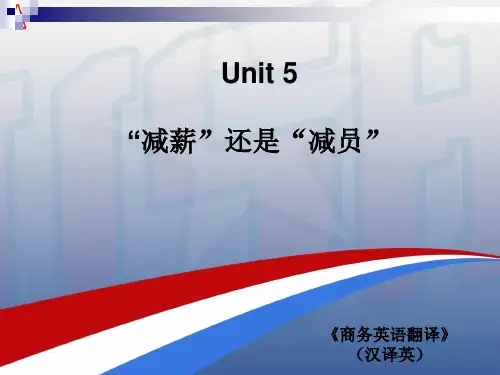
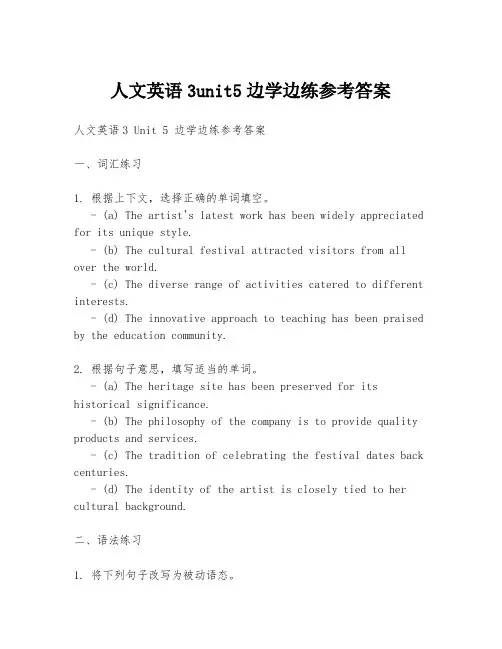
人文英语3unit5边学边练参考答案人文英语3 Unit 5 边学边练参考答案一、词汇练习1. 根据上下文,选择正确的单词填空。
- (a) The artist's latest work has been widely appreciated for its unique style.- (b) The cultural festival attracted visitors from all over the world.- (c) The diverse range of activities catered to different interests.- (d) The innovative approach to teaching has been praised by the education community.2. 根据句子意思,填写适当的单词。
- (a) The heritage site has been preserved for its historical significance.- (b) The philosophy of the company is to provide quality products and services.- (c) The tradition of celebrating the festival dates back centuries.- (d) The identity of the artist is closely tied to her cultural background.二、语法练习1. 将下列句子改写为被动语态。
- (a) The committee will discuss the issue at the next meeting. → The issue will be discussed by the committee atthe next meeting.- (b) People have translated this book into many languages. → This book has been translated into many lan guages by people.- (c) They will publish the report next month. → Thereport will be published next month.- (d) Someone has already seen the film. → The film has already been seen by someone.2. 用正确的时态填空。
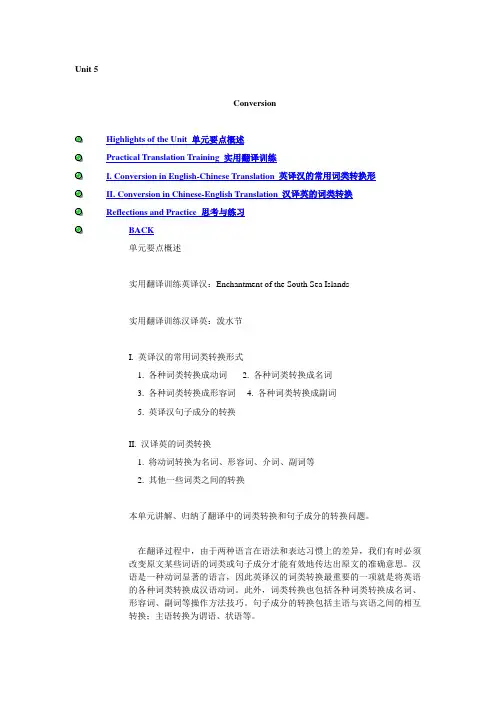
Unit 5ConversionHighlights of the Unit 单元要点概述Practical Translation Training 实用翻译训练I. Conversion in English-Chinese Translation 英译汉的常用词类转换形II. Conversion in Chinese-English Translation 汉译英的词类转换Reflections and Practice 思考与练习BACK单元要点概述实用翻译训练英译汉:Enchantment of the South Sea Islands实用翻译训练汉译英:泼水节I. 英译汉的常用词类转换形式1. 各种词类转换成动词2. 各种词类转换成名词3. 各种词类转换成形容词4. 各种词类转换成副词5. 英译汉句子成分的转换II. 汉译英的词类转换1. 将动词转换为名词、形容词、介词、副词等2. 其他一些词类之间的转换本单元讲解、归纳了翻译中的词类转换和句子成分的转换问题。
在翻译过程中,由于两种语言在语法和表达习惯上的差异,我们有时必须改变原文某些词语的词类或句子成分才能有效地传达出原文的准确意思。
汉语是一种动词显著的语言,因此英译汉的词类转换最重要的一项就是将英语的各种词类转换成汉语动词。
此外,词类转换也包括各种词类转换成名词、形容词、副词等操作方法技巧。
句子成分的转换包括主语与宾语之间的相互转换;主语转换为谓语、状语等。
由于汉语句式中动词的使用频率大大超过英语,因此,要使译文符合英语的习惯表达法,就得将汉语中的大量动词转换为名词、形容词、介词、副词等。
除动词转换之外,汉译英也涉及其他一些词类的转换。
Practical Translation Training1. English-Chinese TranslationEnchantment of the South Sea IslandsThe mighty Pacific washes the shores of five continents-North America, South America,Asia,Australia,and Antarctica. Its waters mingle in the southeast with the Atlantic Ocean and in the southwest with the Indian Ocean. It is not on the shores of continents,nor in the coastal islands,however, that the soul of the great Pacific is found. It lies far out where the fabled South Sea Islands are scattered over the huge ocean like stars in the sky.Here great disturbances at the heart of the earth caused mountains and volcanoes to rise above the water. For hundreds of years tiny coral creatures have worked and died to make thousands of ring-shaped islands called atolls.The air that sweeps the South Sea Islands is fragrant with flowers and spice. Bright warm days follow clear cool nights, and the rolling swells break in a never-ending roar on the shores. Overhead the slender coconut palms whisper their drowsy song.When white men fast came to the Pacific Islands,they found that the people living there were like happy children. They were tall men and beautiful women who seemed not to have a care in the world. Coconut palms and breadfruit trees grew at the doors of their huts. The ocean was filled with turtles and fish,ready for the net. The islanders had little need for clothing. There was almost no disease.Cruel and bloody wars sometimes broke out between neighboring tribes,and canoe raids were sometimes made on nearby islands. The strong warriors enjoyed fighting. Many of the islanders were cannibals,who cooked and ate the enemies they killed. This was part of their law and religion. These savages,however,were usually friendly,courteous,and hospitable. Some of the early explorers were so fascinated with the Pacific Islands that they never returned to their own countries. They preferred to stay.Notes and Explanations1. the South Sea Islands南太平洋诸岛,South Sea南半球诸海洋的,南太平洋的2. wash v. 波涛冲洗、拍打3. mingle with混合,汇合;注意此句中方位的表达顺序4. fabled a.虚构的,富有神奇色彩的5. atoll n. 环状珊瑚岛,环礁6. worked and died 繁衍、死亡7. rolling swells 滚滚巨浪;注意此句翻译中所采用的词类转换的技巧8. drowsy song催眠曲9. filled with turtles and fish, ready for the net 鱼盆成群,张网可得10. canoe raid 乘独木舟进行攻击;注意此句中将被动语态转为主动的翻译方法11. cannibal n.吃人的人2. Chinese-English Translation泼水节泼水是傣族新年的主要喜庆活动。
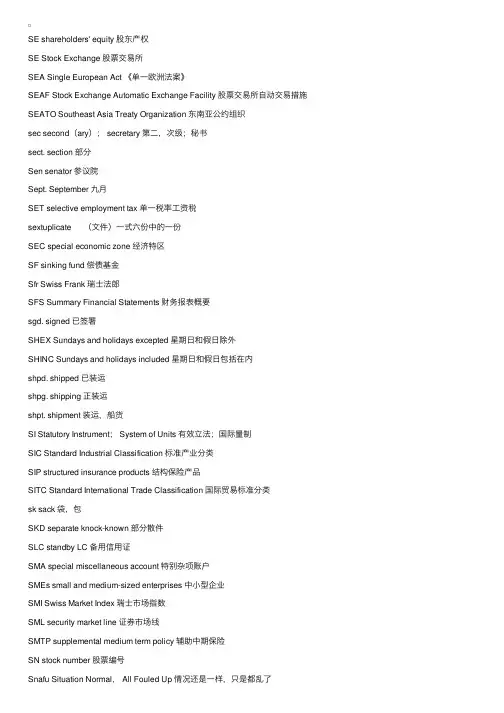
SE shareholders' equity 股东产权SE Stock Exchange 股票交易所SEA Single European Act 《单⼀欧洲法案》SEAF Stock Exchange Automatic Exchange Facility 股票交易所⾃动交易措施SEATO Southeast Asia Treaty Organization 东南亚公约组织sec second(ary); secretary 第⼆,次级;秘书sect. section 部分Sen senator 参议院Sept. September 九⽉SET selective employment tax 单⼀税率⼯资税sextuplicate (⽂件)⼀式六份中的⼀份SEC special economic zone 经济特区SF sinking fund 偿债基⾦Sfr Swiss Frank 瑞⼠法郎SFS Summary Financial Statements 财务报表概要sgd. signed 已签署SHEX Sundays and holidays excepted 星期⽇和假⽇除外SHINC Sundays and holidays included 星期⽇和假⽇包括在内shpd. shipped 已装运shpg. shipping 正装运shpt. shipment 装运,船货SI Statutory Instrument; System of Units 有效⽴法;国际量制SIC Standard Industrial Classification 标准产业分类SIP structured insurance products 结构保险产品SITC Standard International Trade Classification 国际贸易标准分类sk sack 袋,包SKD separate knock-known 部分散件SLC standby LC 备⽤信⽤证SMA special miscellaneous account 特别杂项账户SMEs small and medium-sized enterprises 中⼩型企业SMI Swiss Market Index 瑞⼠市场指数SML security market line 证券市场线SMTP supplemental medium term policy 辅助中期保险SN stock number 股票编号Snafu Situation Normal, All Fouled Up 情况还是⼀样,只是都乱了SOE state-owned enterprises 国有企业SOF State Ownership Fund 国家所有权基⾦sola sola bill, sola draft, sola of exchange (拉丁)单张汇票sov. sovereign ⾦镑=20先令SOYD sum of the year's digits method 年数加总折旧法spec. specification 规格;尺⼨SPF spare parts financing 零部件融资SPQR small profits, quick returns 薄利多销SPS special purpose securities 特设证券Sq. square 平⽅;结清SRM standard repair manual 标准维修⼿册SRP Salary Reduction Plan 薪⽔折扣计划SRT Spousal Remainder Trust 配偶幸存者信托ss semis, one half ⼀半SS social security 社会福利ST short term 短期ST special treatment (listed stock)特别措施(对有问题的上市股票)St. Dft. sight draft 即期汇票STB special tax bond 特别税债务STIP short-term insurance policy 短期保险单sub subscription; substitute 订阅,签署,捐助;代替Sun Sunday 星期⽇sund. sundries 杂货,杂费sup. supply 供应,供货t time; temperature 时间;温度T. ton; tare 吨;包装重量,⽪重TA telegraphic address=cable address 电报挂号TA total asset 全部资产,资产TA trade acceptance 商业承兑票据TA transfer agent 过户转账代理⼈TAB tax anticipation bill (美国)预期抵税国库券TACPF tied aid capital projects fund 援助联系的资本项⽬基⾦TAF tied aid financing 援助性融资TAL traffic and accident loss (保险)交通和意外事故损失TAT truck-air-truck 陆空联运TB treasury bond, treasury bill 国库券,国库债券T.B. trial balance 试算表t.b.a. to be advised; to be agreed; to be announced; to be arranged 待通知;待同意;待宣布;待安排t.b.d. to be determined 待(决定)TBD policy to be declared policy 预保单,待报保险单TBL through bill of lading 联运提单,直达提单TBV trust borrower vehicle 信托借款⼈⼯具(公司)TBW Thompson Bankwatch, a rating agent 托马逊银⾏评估公司TC tariff circular 关税通报TC telegraph collation 校对电报T.C. traveler's check 旅⾏⽀票TCI trade credit insurance 贸易信⽤保险TCIC technical credit insurance consultants 技术信⽤保险顾问TCM traditional Chinese medicine 中国传统医学,中医TD time deposit 定期存款TD Treasury Department (美国)财政部TDA Trade Development Authority 贸易发展*TDC technical development corporation 技术开发公司TDC Trade Development Council (⾹港)贸易发展局TDR Treasury Deposit Receipt 国库券存据Tech technical 技术的Tel. telephone number 电话号码telecom telecommunications 通讯temp temperature; temporary (secretary)温度;临时(秘书)TESSA Tax Exempt Special Savings Account 免税特别储蓄帐户TEU twenty-foot-equipment unit (货柜、集装箱)20英尺当量单位TF trade finance 贸易融资t.f. till forbid 直到取消为⽌tgm. telegram 电报three T's type, terms, technique 交易三要素,即交易类型,交易条件,销售技术thro., thru. through 经由,通过Thu. Thursday 星期四TIP to insure promptness 确保迅速TIR carnet Transports Internationaux Routier (法国)国际公路运输证tks. thanks 致谢,感谢tkt ticket 票TL time loan; total loss; trade-last 定期贷款;总损失;最后交易TLO, T.L.O. total loss only=free from/of all average 全损赔偿险TLX telex=teleprinter/teletypewriter exchange 电传TM trademark 商标TM telegram with multiple addresses 分送电报TMA Terminal Market Association 最终市场协会TMO telegraph money order 电汇单TN treasury note 国库券TNC transnational/multinational company 跨国公司TOD time of delivery 发货时间Tonn. tonnage 吨位(数)Trade Opportunities Program (美国)贸易机会计划T.O.P. turn over, please 请翻转TPM total productive maintenance 总⽣产维修(护)制TPND theft, pilerage, and non-delivery 偷窃及不能送达险tpo telephoto 电传照⽚,传真TQ tariff quota 关税配额T.Q., t.q. tale quale (拉丁)按现状,现状条件TQC total quality control 全⾯质量控制TR telegram restante; trust receipt 留交电报;信托收据T.R. tons registered (船舶)注册吨位Tr. transfer 过户,转让traditio symbolia (拉丁)象征性交费Tranche CD certificate of deposit 份额存单trans translated 译本treas treasurer 会计,出纳,库管,司库Trip. triplicate ⼀式三份中的⼀份Triple A 3A 3A级,债券评级TRS terminal receiving system 港外待运仓收货制度TRT Trademark Registration Treaty 商标注册条约TSP Total Suspended Particle 总空中悬浮物(污染指标)TST test 检查,检测TT Testamentary Trust 遗嘱信托TT, T/T telegraphic transfer 电汇T.T.B. telegraphic transfer bought 买⼊电汇T.T.S. telegraphic transfer sold 卖出电汇TTY teletypewriter 电报打字员TU Trade Union ⼯会,职⼯协会Tue, Tues Tuesday 星期⼆TV terminal value; television 最终价值;电视TW transit warehouse 转⼝仓库TWI training within industry 业内训练txt. text 课⽂,电⽂,正⽂Ty. territory 领⼟,(推销员的)推销区域T&E Card travel and entertainment card 旅⾏和娱乐信⽤卡T&H temperature and humidity 温度和湿度T&M time and material 时间和材料T/C time charter 定期租船,计时租船t/km ton kilometer 顿/千⽶U union; upper; fashionable; polite 联盟;上等;时髦;礼貌U, U. unit; United 单位;联合的;联合(公司)U.A. unit of account 记账单位,记价单位U.K./Cont. United Kingdom or Continent 英国或欧洲⼤陆(港⼝)U.K.f.o. United Kingdom for orders 英国沿岸的指定港⼝U.L.C.C. ultra large crude carrier 超⼤型油轮U/A underwriting account 保险帐户u/c. undercharge 不⾜的价钱,少讨的价钱U/M unscheduled maintenance 计划外维护U/W, UW underwriters 保险公司,承销⼈UAE the Union of Arab Emirates (阿拉伯联合酋长国)阿联酋Uberrimae fidei of the utmost good faith 最诚信的UBR uniform business rate 统⼀商业税率UBS Union Bank of Switzerland 瑞⼠联合银⾏UCP Uniform Customs and Practice (for Documentary Credit)(跟单信⽤证)统⼀惯例与事物UGT, ugt urgent (电报⽤语)急电,加急UHF ultra high frequency 超⾼频UIT Unit Investment Trust 单位投资信托UITF Urgent Issue Task Force (财务报表)紧急补救解释处Ull. ullage 缺量,损耗ult. ultimo (拉丁)(商业函电)上⽉的Ultra vires beyond the powers of 超过……的权限(有限公司)UN United Nations 联合国undelvd. undelivered 未装运的Univ university ⼤学unkwn. unknown. 未知的unrevd. unreceived 未收到的UNSYM unsymmetrical 不对称的UOS unless otherwise specified 除⾮有特别说明UPC Uniform Practice Code 《统⼀作法法典》UPR unearned premiums reserve 未获得保险⾦储备ur. your 你的US United States; Unlisted securities 美国;未上市证券USD United States dollar 美元USG United States gallon 美国加仑USIT Unit Share Investment Trust 单位股投资信托USM Unlisted Securities Market 为挂牌(上市)证券市场UT universal time 世界标准时间,格林威治时间UUE use until exhausted ⽤完为⽌UV under voltage; ultraviolet 电压不⾜;紫外线v refer to 参见v., vs versus (拉丁)对V Roman 5; victory; volt (罗马数字)5;胜利;(电压)伏V.A. value analysis 价值分析VAB vertical assembly building 垂直装配建筑物vac vacation 假期vac. vacant (职位)空缺,(旅馆、公寓)空房间VAT value added tax 增值税VC Vice Chairman; Vice Chancellor; Vice Consul 副主席;副⾸相;副总理;副领事VD volume deleted 勾销的数量VE value engineering 价值⼯程Veep Vice president 副总裁VER voluntary export restraint ⾃愿出⼝限制Ves. vessel 船舶via. through, by way of 经由,通过vid vide (see)(拉丁)参看,请看VIP Very Important Person 贵宾vis major (拉丁)不可抗⼒viz. videlicet, namely (拉丁)即,也就是VL value line investment survey 价值线投资概览法V-mail video-mail 声像电⼦邮讯系统VOD video on demand 交互电视技术系统vol. volume 量,额,本,卷,容积voy. voyage 航海,航程VQA vendor quality assurance 售主质量保证VQC vendor quality certification 售主质量确认VQD vendor quality defect 售主质量缺陷VRM variable rate mortgage 可变利率抵押VS/N vendor serial number 售主系列号VSI vendor shipping instruction 售主船运说明VSO Voluntary Service Overseas 海外义务服务VSQ very special quality 特级质量VSSP vendor standard settlement program 售主标准程序结算VTC Voting Trust Certificate 股东投票权信托证书VTP vendor test program 售主检测计划VTR video tape record 录像带录像W weight ton; winter mark for load line; won 重量吨;(船舶)冬季装载线标记;(韩国)元W., w. warehouse; watt; weight; width; week 仓库;⽡特;钟量;宽;星期W.A. with average ⽔渍险,保单独海损险W.A.C.C.C. Worldwide Air Cargo Commodity Classfication 全球空运商品分类W.A.I.O.P. W.A. irrespective of percentage 单独海损不计免赔率,单独海损全赔WAEC West African Economic Community 西⾮经济共同体WAG wagon 卡车WAN Wide Area Networks 泛区络WASH Washington; washer 华盛顿;洗⾐机WB, W.B. waybill 运送单WB World Bank 世界银⾏。
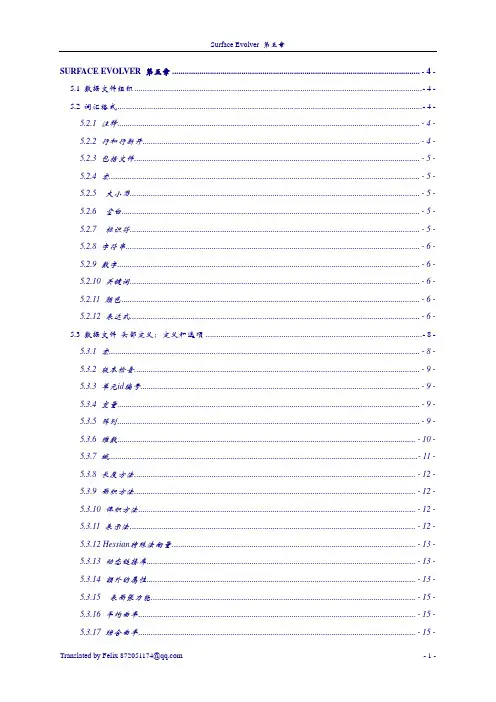
SURFACE EVOLVER 第五章......................................................................................................................- 4 -5.1数据文件组织 (4)5.2词汇格式 (4)5.2.1 注释................................................................................................................................................- 4 -5.2.2 行和行断开....................................................................................................................................- 4 -5.2.3 包括文件........................................................................................................................................- 5 -5.2.4 宏....................................................................................................................................................- 5 -5.2.5 大小写..........................................................................................................................................- 5 -5.2.6 空白..............................................................................................................................................- 5 -5.2.7 标识符..........................................................................................................................................- 5 -5.2.8 字符串............................................................................................................................................- 6 -5.2.9 数字................................................................................................................................................- 6 -5.2.10 关键词..........................................................................................................................................- 6 -5.2.11 颜色..............................................................................................................................................- 6 -5.2.12 表达式..........................................................................................................................................- 6 -5.3数据文件头部定义:定义和选项 (8)5.3.1 宏....................................................................................................................................................- 8 -5.3.2 版本检查........................................................................................................................................- 9 -5.3.3 单元id编号.....................................................................................................................................- 9 -5.3.4 变量................................................................................................................................................- 9 -5.3.5 阵列................................................................................................................................................- 9 -5.3.6 维数..............................................................................................................................................- 10 -5.3.7 域...................................................................................................................................................- 11 -5.3.8 长度方法......................................................................................................................................- 12 -5.3.9 面积方法......................................................................................................................................- 12 -5.3.10 体积方法....................................................................................................................................- 12 -5.3.11 表示法........................................................................................................................................- 12 -5.3.12 Hessian特殊法向量....................................................................................................................- 13 -5.3.13 动态链接库................................................................................................................................- 13 -5.3.14 额外的属性................................................................................................................................- 13 -5.3.15 表面张力能..............................................................................................................................- 15 -5.3.16 平均曲率....................................................................................................................................- 15 -5.3.17 综合曲率....................................................................................................................................- 15 -5.3.19 平方高斯曲率............................................................................................................................- 15 -5.3.20 理想气体模型............................................................................................................................- 16 -5.3.21 重力............................................................................................................................................- 16 -5.3.22 间隙能量....................................................................................................................................- 16 -5.3.23 节点能量....................................................................................................................................- 16 -5.3.24 曲率的机动性和运动................................................................................................................- 16 -5.3.25 退火............................................................................................................................................- 17 -5.3.26 扩散............................................................................................................................................- 17 -5.3.27 命名的品质实例........................................................................................................................- 17 -5.3.28 命名的品质................................................................................................................................- 18 -5.3.29 水平集约束................................................................................................................................- 19 -5.3.30 约束误差....................................................................................................................................- 20 -5.3.31 边界............................................................................................................................................- 20 -5.3.32 数值积分精度............................................................................................................................- 21 -5.3.33 步长系数....................................................................................................................................- 21 -5.3.34 移动性........................................................................................................................................- 21 -5.3.35 标准度量..................................................................................................................................- 22 -5.3.36 Autochopping...........................................................................................................................- 22 -5.3.37 Autopopping...........................................................................................................................- 22 -5.3.38 总时间......................................................................................................................................- 23 -5.3.39 Runge-Kutta 龙格-库塔方法..................................................................................................- 23 -5.3.40 相似缩放....................................................................................................................................- 23 -5.3.41 视角矩阵....................................................................................................................................- 23 -5.3.42 View transforms...........................................................................................................................- 24 -5.3.43 View transform generators..........................................................................................................- 24 -5.3.44 放大参数....................................................................................................................................- 25 -5.3.45 其他的体积方法........................................................................................................................- 25 -5.3.46 固定面积约束............................................................................................................................- 25 -5.3.47 Merit factor.................................................................................................................................- 25 -5.3.48 参数文件....................................................................................................................................- 25 -5.3.49 消除警告....................................................................................................................................- 26 -5.4单元列表.. (26)5.6边列表 (27)5.7面列表 (27)5.8体 (28)5.9命令 (29)后记: (29)Surface Evolver 第五章5.1 数据文件组织初始配置的表面是从ASCII码的数据文件阅读的。
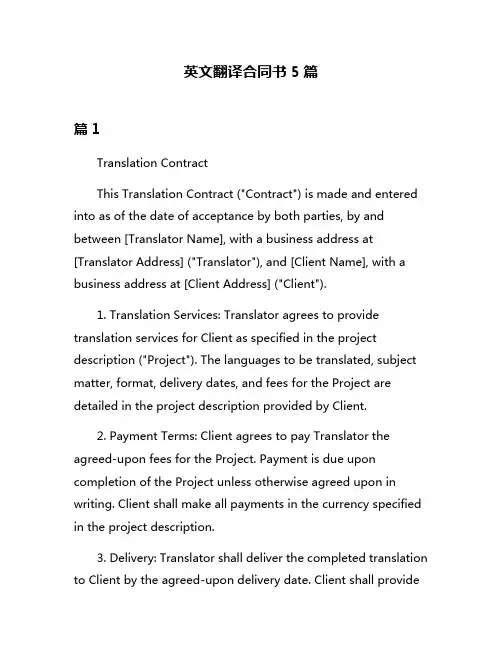
英文翻译合同书5篇篇1Translation ContractThis Translation Contract ("Contract") is made and entered into as of the date of acceptance by both parties, by and between [Translator Name], with a business address at [Translator Address] ("Translator"), and [Client Name], with a business address at [Client Address] ("Client").1. Translation Services: Translator agrees to provide translation services for Client as specified in the project description ("Project"). The languages to be translated, subject matter, format, delivery dates, and fees for the Project are detailed in the project description provided by Client.2. Payment Terms: Client agrees to pay Translator the agreed-upon fees for the Project. Payment is due upon completion of the Project unless otherwise agreed upon in writing. Client shall make all payments in the currency specified in the project description.3. Delivery: Translator shall deliver the completed translation to Client by the agreed-upon delivery date. Client shall providenecessary information and feedback in a timely manner to facilitate the completion of the Project.4. Revisions: Client may request revisions to the translation within [number of days] days of delivery. Translator shall make reasonable efforts to accommodate Client's revision requests, provided that they are within the scope of the original Project description.5. Confidentiality: Translator agrees to keep all information related to the Project confidential and to not disclose any information to third parties without Client's written consent.6. Copyright: Upon payment of the agreed-upon fees, Client shall own the copyright to the translation. Translator retains the right to use samples of the translation for marketing and promotional purposes.7. Termination: Either party may terminate this Contract with written notice if the other party breaches any material term of the Contract. Upon termination, Client shall pay Translator for all services rendered up to the date of termination.8. Governing Law: This Contract shall be governed by the laws of [State/Country] and any disputes arising from this Contract shall be resolved through arbitration in [City/State].In witness whereof, the parties have executed this Contract as of the date first written above.Translator: ___________________________ Date: _______________Client: ______________________________ Date: _______________This Contract is effective as of the date of acceptance by both parties.[Translator Name][Translator Address][Client Name][Client Address]篇2Translation ContractThis Translation Contract (the "Contract") is made and entered into as of [date], by and between [Translator's Name], with an address at [Translator's Address] (the "Translator"), and [Client's Name], with an address at [Client's Address] (the "Client").1. Services ProvidedThe Translator agrees to provide translation services for the Client as specified in Exhibit A attached hereto. The Translator shall provide accurate and faithful translations of the text provided by the Client in the agreed upon language pair.2. DeliveryThe Translator shall deliver the completed translations to the Client by the agreed upon deadline. Delivery shall be made in the form of a Word document, unless otherwise specified by the Client.3. PaymentThe Client shall pay the Translator the agreed upon fee for the services provided. Payment is due within 30 days of receipt of the completed translations. If payment is not received within the specified time frame, the Translator has the right to withhold further services until payment is made.4. Ownership of TranslationsUpon receipt of payment, the Client shall own the completed translations and all rights related to them. The Translator agrees to transfer all rights to the translations to the Client upon payment.5. ConfidentialityThe Translator shall keep all information provided by the Client confidential and shall not disclose it to any third party without the Client's consent. The Translator shall take all necessary precautions to protect the Client's information.6. TerminationEither party may terminate this Contract with written notice to the other party. In the event of termination, the Client shall pay the Translator for all services rendered up to the date of termination.7. Governing LawThis Contract shall be governed by and construed in accordance with the laws of [State/Country].IN WITNESS WHEREOF, the parties hereto have executed this Contract as of the date first written above.[Translator's Name] [Client's Name]Exhibit A: Translation ServicesThe Translator agrees to translate the following documents for the Client:1. Document A – [brief description]2. Document B – [brief description]3. Document C – [brief description][Add additional documents as needed]This Contract is hereby agreed to by the parties hereto on the date first above written.[Translator's Name] [Client's Name]篇3Translation ContractThis Agreement is between the Client (hereinafter referred to as "Client") and the Translator (hereinafter referred to as "Translator") for the translation of certain materials from the source language to the target language.1. Responsibilities of the Translator:1.1 The Translator agrees to accurately translate the materials provided by the Client from the source language to the target language.1.2 The Translator will provide the Client with the translated materials within the agreed upon timeframe.1.3 The Translator will maintain the confidentiality of all materials provided by the Client and will not disclose any information to third parties.2. Responsibilities of the Client:2.1 The Client agrees to provide the Translator with all necessary materials and information needed for the translation.2.2 The Client agrees to pay the Translator the agreed upon fee for the translation services rendered.2.3 The Client will provide feedback to the Translator on the translated materials and will promptly communicate any changes or revisions needed.3. Payment:3.1 The Client agrees to pay the Translator the agreed upon fee for the translation services rendered.3.2 Payment will be made within 30 days of receiving the translated materials.3.3 Payment will be made in the currency agreed upon by both parties.4. Termination:4.1 Either party may terminate this Agreement with written notice to the other party.4.2 In the event of termination, the Client will pay the Translator for all services rendered up to the date of termination.5. Governing Law:This Agreement shall be governed by and construed in accordance with the laws of [Jurisdiction].This Agreement constitutes the entire understanding between the Client and the Translator with respect to the translation services provided and supersedes all prior agreements, discussions, and understandings, whether written or oral.Client Signature: _______________________________Translator Signature: ____________________________Date: _______________________This Translation Contract is hereby agreed to by the Client and the Translator on the date written above.[End of Contract](Note: This is a sample translation contract and should be customized to fit the specific needs of the Client and Translator.)篇4Translation ContractThis Translation Contract (the "Contract") is entered into as of [Date] (the "Effective Date") by and between [Translator Name] ("Translator") and [Client Name] ("Client").1. Services ProvidedThe Translator agrees to provide translation services to the Client in accordance with the terms and conditions set forth in this Contract. The Translator will translate the documents provided by the Client from [Source Language] to [Target Language] with accuracy and diligence.2. Fees and PaymentThe Client agrees to pay the Translator a fee of [Fee Amount] for the translation services provided under this Contract. Payment shall be made in full within [Number] days of receipt of the translated documents. Late payments shall incur a fee of [Late Fee Amount]. All payments shall be made in [Currency]. In the event that payment is not received within [Number] days ofthe due date, the Translator reserves the right to cease work until payment is received.3. DeliveryThe Translator agrees to deliver the translated documents to the Client by [Delivery Date]. The Client shall provide the Translator with all necessary information and materials required for the translation services, including but not limited to glossaries, style guides, and reference materials.4. RevisionsThe Client may request revisions to the translated documents within [Number] days of delivery. The Translator agrees to make reasonable revisions to the documents at no additional charge. Additional revisions may be subject to an additional fee.5. ConfidentialityThe Translator agrees to keep all information and materials provided by the Client confidential and not to disclose or use such information for any purpose other than the translation services provided under this Contract.6. TerminationEither party may terminate this Contract at any time by providing [Number] days' written notice to the other party. In the event of termination, the Client agrees to pay the Translator for any completed work, and the Translator agrees to deliver all translated documents to the Client.7. Governing LawThis Contract shall be governed by and construed in accordance with the laws of [Jurisdiction]. Any disputes arising out of or relating to this Contract shall be resolved through arbitration in [Arbitration Location].In witness whereof, the parties hereto have executed this Contract as of the Effective Date.Translator: [Translator Name] Date: [Date]Client: [Client Name] Date: [Date]篇5Translation ContractThis Translation Contract ("Contract") is entered into on [Date], by and between [Translator], with a mailing address at [Translator's Address] ("Translator") and [Client], with a mailing address at [Client's Address] ("Client").WHEREAS, Client desires to have certain materials translated into [Target Language]; andWHEREAS, Translator has the necessary skills, expertise, and qualifications to provide high-quality translation services in [Source Language] to [Target Language];NOW, THEREFORE, in consideration of the mutual covenants and promises contained herein, the parties agree as follows:1. Services. Translator agrees to provide translation services for Client's materials in [Source Language] to [Target Language]. The translated materials shall be delivered to Client in the agreed-upon format and within the agreed-upon timeline.2. Fee. Client agrees to pay Translator the sum of [Amount] for the translation services to be rendered under this Contract. The fee shall be paid in [Payment Terms] upon completion of the services.3. Timeline. Translator shall complete the translation of the materials within [Number] days of receipt of the materials from Client. Any delays in the delivery of the materials from Client may result in a corresponding extension of the timeline.4. Revisions. Translator agrees to make reasonable revisions to the translated materials at Client's request. Any substantialrevisions beyond the scope of the original agreement may result in an additional fee.5. Confidentiality. Translator shall treat all materials provided by Client as confidential and shall not disclose any information contained in the materials to any third party without Client's prior written consent.6. Termination. Either party may terminate this Contract with [Number] days' written notice to the other party. In the event of termination, Translator shall be compensated for services rendered up to the date of termination.7. Governing Law. This Contract shall be governed by the laws of the state of [State] without regard to its conflict of law principles.IN WITNESS WHEREOF, the parties hereto have executed this Contract as of the date first above written.[Translator Name] [Client Name]____________________ ____________________Translator ClientI hereby acknowledge receipt of this Contract and agree to the terms and conditions outlined herein.[Client Name] ________________ Date: ________________。
五的英文翻译The number five can be translated into "five" in English. It is a cardinal number that comes after four and before six. In English, the number five is pronounced as "fahyv" and is written as "5" in numeral form.The number five has various cultural and symbolic meanings in different contexts. In mathematics, it represents the middle number of the first ten positive integers. It is also an odd number, meaning it is not divisible evenly by two.In nature, five is commonly associated with the five fingers on a hand or the five toes on a foot. It is also significant in many human senses, such as the five senses: sight, hearing, taste, smell, and touch.In many cultures, the number five holds symbolic importance. In Chinese culture, for example, it is considered a lucky number and is associated with the five elements: metal, wood, water, fire, and earth. In Western culture, the number five is often seen as a symbol of balance and harmony.In sports, the number five is often used to represent a team member or player. In basketball, for example, the number five is typically worn by the center player. In soccer, it is commonly associated with the defensive midfielder.There are also many phrases and idioms that include the number five in English. "Take five" is a common phrase that means to take a break or rest for a short period of time. "High five" is anotherpopular expression that involves slapping hands with another person to celebrate or show agreement.Overall, the number five has various meanings and uses in English. It is a significant number in mathematics, nature, culture, and sports. Whether it is representing the five senses, elements, or fingers on a hand, the number five plays an important role in the English language and society as a whole.。
Module 6 (单词短语篇)Ⅰ.单句语法填空1.He's devoted his whole life to the__________(protect) of the rare animals.2.This is an__________(idea) place for a picnic.3.The polluted air in the city is badly__________(endanger) the health of the residents.4.The article is well worth__________(read),but it is not worthy of__________(translate).5.Tony lent me the money,__________(hope) that I'd do as much for him.6.The working people have never stopped their struggle__________unfair treatment.7.On Sunday,both my wife and I did some cleaning.She washed some clothes,__________,I cleaned the house.8.Don't try to do everything at once;take it a bit at__________time.9.Mr.Smith advised us to fix a written agreement________it was just a small deal.10.Having found many of her clothes out of date,she decided to buy some__________fashion on the Internet.答案1.protection 2.ideal 3.endangering4.reading;being translated 5.hoping 6.against7.meanwhile 8.a 9.though/although 10.inⅡ.选词填空in danger,struggle for,protect from,on the spot,come into fashion,put down,get tough with,thanks to,at a time,take an active part in1.The people are__________;we must help them off.2.What I'd like to do is fire you__________.3.The government will__________people who avoid paying taxes.4.Since being a manager,Robert__________employees' respect.5.That style of coat__________when I was a boy.6.The Chinese economy has made these achievements __________reform and innovation.7.Beat in the eggs,one__________.8.The sheep jammed together to__________the cold.9.The army should support and__________national construction.10.After two rings I__________the phone.答案1.in danger 2.on the spot 3.get tough with4.has struggled for 5.came into fashion 6.thanks to7.at a time 8.protect from 9.take an active part in10.put downⅢ.完形填空(2016年高考·浙江卷)During the war,my husband was stationed at an army camp in a desert in California.I went to live there in order to be __1__ him.I hated the place.I had never __2__ been so unhappy.My husband was ordered out on a longterm duty,and I was left in a tiny shack (棚屋) alone.The heat was __3__——almost 125 even in the shade of a cactus (仙人掌).__4__ a soul to talk to.The wind blew nonstop,and all the food I ate,and the very air I breathed,were __5__ with sand,sand,sand!I was so sorry for myself that I wrote to my parents.I told them I was __6__ and coming back home.I said I couldn't stand it one minute longer.I __7__ be in prison!My father answered my __8__ with just two lines—two lines that will always sing in my __9__ —two lines that completely changed my life:Two men looked out from prison bars,One saw the mud,the other saw the stars.I read those two lines __10__.I was ashamed of myself.I made up my mind I would find out what was good in my present __11__;I would look for the stars.I made friends with the natives,and their __12__ amazed me.They gave me presents of their favorite artworks which they had __13__ to sell to tourists.I studied the delightful forms of the cactus.I watched for the desert sunsets,and __14__ for seashells that had been left there millions of years ago when the sands of the desert had been an ocean __15__.What brought about this __16__ change in me?The desert hadn't changed,__17__ I had.I had changed my __18__.And by doing so,I changed an unhappy experience into the most amazing __19__ of my life.I was excited by this new world that I had discovered.I had looked out of my selfcreated prison and __20__ the stars.1.A.off B.behindC.near D.beyond2.A.before B.alreadyC.then D.still3.A.inflexible B.incomprehensibleC.uncontrollable D.unbearable4.A.Only B.NotC.Many D.Such5.A.covered B.filledC.buried D.charged6.A.catching up B.keeping upC.giving up D.getting up7.A.ought to B.might wellC.would rather D.had better8.A.request B.callC.question D.letter9.parison B.imaginationC.consideration D.memory10.A.over and over B.by and byC.up and down D.now and then11.pany B.occupationC.situation D.relationship12.A.movement B.reactionC.guidance D.purpose13.A.refused B.failedC.managed D.happened14.A.asked B.huntedC.waited D.headed15.A.floor B.surfaceC.rock D.level16.A.shocking B.challengingC.puzzling D.astonishing17.A.as B.butC.for D.or18.A.attitude B.principleC.identity D.standard19.A.vacation B.operationC.affair D.adventure20.A.sought B.countedC.found D.reached答案与解析这是一篇夹叙夹议文。
星期一到星期五的英语计划表English:On Monday to Friday, my schedule includes a mix of work, exercise, and leisure activities. I wake up at 7 am every morning and start my day with a quick workout at the gym. After showering and having breakfast, I head to work at 9 am. I spend the morning working on various projects and attending meetings. At noon, I take a break for lunch and catch up with colleagues. In the afternoon, I continue to work until 5 pm when I finish for the day. On Monday and Wednesday evenings, I attend a yoga class to unwind and relax. Tuesdays and Thursdays are reserved for dinner with friends or family. Fridays are my favorite day as I usually go out for dinner or have a movie night at home. Before going to bed, I like to read for a bit or watch a TV show to wind down. Overall, my weekdays are a good balance of work, socializing, and self-care activities.Translated content:星期一到星期五,我的日程安排包括工作、运动和休闲活动。
2.2.3 省略法省略法也被称为减词法(pruning)。
跟增词法刚好相反,省略法是指把原文中有的词语省掉不译出来,但省掉的都是一些可有可无的或违背译语语言习惯的词,如实词众的代词、动词的省略,虚词中的冠词、介词和连词的省略等,目的是为了在忠实的基础上使译文更加简洁通顺。
一、由于语法差异而需要省略:1.代词的省略:英语中代词的使用频率远远高于汉语,根据实际情况有时需要把代词所指代的人或事物重复出来,而有时则可以直接省掉,有人称代词(主格或宾格),物主代词等。
例1.Order is order. We cannot complain, we cannot bargain, we cannot question and we cannot suggest changes.命令就是命令,不得抱怨,不得讨价还价,不得置疑,不得建议修改。
例2.One must make painstaking efforts before one can master a foreign language.要掌握一门外语非下苦功夫不可.例3.He put his hands in his pockets and then shrugged his shoulders.他把双手放进衣兜里,耸了耸肩。
例4. A person with nerve damage in the spinal cord can grasp objects when his or her forearms are activated by a device like this one.脊髓神经有损伤的人使用这样的装置后,前臂肌肉被激活,便能抓住东西。
2.It的省略:it作形式主语或宾语,强调句中的it,或表示自然现象、时间、地点、距离等的it常常可以省略。
例:P313.连接词的省略:英语是一种形合的语言,连接词使用较多;而汉语是一种意合的语言,上下文的关系往往是暗含的,所以原文的一些连接词常常可以省略。
IEC60255-5 译本Second editionTranslated by: Jiangping Chen电气继电器第五部分:测量继电器和保护设备的绝缘配合要求和测试Electrical relays—Part 5: Insulation coordination for measuring relays and protection equipment Requirement and tests电气继电器第五部分:测量继电器和保护设备的绝缘配合要求和测试IEC60255-51 范围和目的本标准适用于测量继电器和保护设备的绝缘配合一般要求。
注:本标准中除非特别说明,“测量继电器和保护设备”缩写为“继电器“。
本标准中,特别作说明的有以下几点:---术语的定义;---对于电气继电器的电气间隙、爬(漏)电距离与绝缘有关的其他方面的严酷等级的选择提供导则;---规定电压试验(包括冲击耐压试验)和绝缘电阻试验的要求。
本标准适用于额定电压交流至1000v,额定频率至65Hz或直流至1500v设备,其安装或使用于海拔高度至2000m。
本标准也适用于诸如分流器、串联电阻器、互感器等有关的辅助装置,这些装置与上述电气继电器一起使用并一起进行试验,若这些装置在相关的国际电工委员会出版物另有规定的除外。
注:对于海拔高度超过2000m装置的电气间隙参照表B.1。
2 引用标准下列标准所包含的条文,通过在本标准中引用而构成本标准的条文。
对于注日期的引用文件,其随后所有的修改单(不包括勘误的内容)或修订版均不适用于本标准,然而,鼓励根据本标准达成协议的各方研究是否可使用这些文件的最新版本。
凡是不注日期的引用文件,其最新版本适用于本标准。
国际标准化组织和国际电工委员会成员负责登记目前采用的国际标准有效性。
IEC 60050(151):1978, International Electro-technical Vocabulary (IEV) – Chapter 151: Electrical and magnetic devices IEC 60050(448):1995, International Electro-technical Vocabulary – Chapter 448: Power system protectionIEC 60060-1:1989, High-voltage test techniques – Part 1: General definitions and test requirementsIEC 60085:1984, Thermal evaluation and classification of electrical insulationIEC 60112:1979, Method for determining the comparative and the proof tracking indices of solid insulating materials under moist conditionsIEC 60255 (all parts), Electrical relaysIEC 60255-21-1:1988, Electrical relays – Part 21: Vibration, shock, bump and seismic tests on measuring relays and protection equipment – Section 1: Vibration tests (sinusoidal)IEC 60255-21-2:1988, Electrical relays – Part 21: Vibration, shock, bump and seismic tests on measuring relays and protection equipment – Section 2: Shock and bump testsIEC 60255-21-3:1993, Electrical relays – Part 21: Vibration, shock, bump and seismic tests on measuring relays and protection equipment – Section 3: Seismic testsIEC 60664-1:1992, Insulation coordination for equipment within low-voltage systems – Part 1:Principles, requirements and testsIEC 61000-4-5:1995, Electromagnetic compatibility (EMC) – Part 4: Testing and measurement techniques – Section 5: Surge immunity testIEC 61180-1:1992, High-voltage test techniques for low-voltage equipment – Part 1: Definitions and test procedure requirementsIEC 61180-2:1994, High-voltage test techniques for low-voltage equipment – Part 2: Test equipment3 定义本标准采用下列术语和定义,对于未规定的定义和术语应引用IEC 60050(448)、IEC 60664-1和IEC60255相关部分。
第7章本章阅读前提在阅读本章内容之前,大家最好先熟悉下面这些章节的内容:第1章“通用网络概览”,第3章“以太网”,第4章“令牌环网和FDDI”和第6章“LAN交换技术”。
此外,大家也应该对十六进制与二进制,十六进制与十进制,十进制与二进制数的相互转换很熟悉,这并不仅阅读本章的前提条件,而且还是CCIE考试的一个要求。
别的一些桥路转发技术本章导读1. 4种主要的不可路由协议是什么?2. CRB与IRB的区别是什么?3. BVI的功能是什么?4. 在SRB环境中,终端工作站之间的数据通讯路径是由什么设备决定的?5. 浏览器的功能是什么?6. RIF的功能是什么?7. 令牌环号需要多少位来指定?8. SRB环境中的最大跃距数是多少?9. RSRB和SRB的区别是什么?10. 在SRT环境中,一个数据帧能否进入SRB域是由什么决定的?实践部分请参考附录F。
和路由转发工作在网络层不同,桥路转发是在OSI/RM模型的数据链路层上工作着的。
第6章“LAN交换技术”讨论的是透明桥路的概念,这一章将要讲述的是通过网络传输不可路由协议的一些技术,具体地说包括桥路转发的类型,如何将路由器配置为桥路,以及更为常用的如何与大型机交换SNA数据等。
从以前的情况来看,桥路转发部分在CCIE笔试中占有很大的比重,因此,这一章的内容需要全面深入的理解以通过CCIE的考查。
不可路由的协议尽管绝大多数的桥路应用场合应用的都是SNA,但是这并不是桥路的唯一用途。
别的一些不可路由协议只能工作在OSI/RM模型的数据链路层上。
下面列出的就是一些不可路由的协议的情况:♉ DEC LAT (DEC的局域传输协议)♉ DEC MOP (DEC的维护操作协议)♉ NetBIOS (网络输入输出系统)♉ SNA (系统网络架构)NetBIOS在网络中传输的时候,最常用的是封装成TCP/IP的形式,此外还有就是封装成IPX的形式。
如果NetBIOS没有封装成网络层协议的形式,而是在LLC2子层上运行,那它就需要通过桥路进行传输。
NetBIOS也称为NetBEUI (NetBIOS扩展用户接口)。
关键概念不可路由协议主要包括SNA,NetBIOS,DEC LAT和DEC MOP。
并发性路由与桥路转发Cisco的CCIE考试规划将并发性路由与桥路转发(CRB)也列为了考试内容之一。
CRB 采用单台路由器在一组接口上通过桥路转发一个可路由的协议,同时在另一组接口上对该协议通过路由进行转发。
CRB和集成路由与桥路(本章后面将要讨论的IRB)不同,在CRB中,路由和桥路是在不同的接口上进行的。
CRB的工作情况图7.1以IP为可路由协议对此进行了解释。
图中左边部分是路由转发接口,而右边则是透明桥路转发接口。
CRB不会对不可路由的协议造成影响,这些协议是通过桥路组命令来转发的。
图7.1CRB环境中的路由和桥路转发过程两组接口之间的数据只有满足了下面的这两个条件之一才能够在相互之间进行交换:♉ 桥路接口做了相应的网络层配置(也就是用IP进行了配置)。
♉ 路由接口也作为桥路接口加入到了桥路组中去。
在CRB工作环境中,如果接口e0和e1同时也在bridge-group 1 组中(比方说,允许NetBEUI 进行桥路转发),路由器就也能通过桥路转发IP数据。
为了达到此目的,还需要配置一条外部桥路路由命令。
关键概念CRB是并发性的在通过一组接口进行路由转发的同时又在另一组接口上进行桥路的转发。
其中一组接口的数据是禁止进入另一组接口中去的。
CRB的配置下面就是对图7.1中的路由器进行配置的情况:interface Ethernet0ip address 10.1.0.1 255.255.255.0interface Ethernet1ip address 10.1.1.1 255.255.255.0interface Ethernet2no ip addressbridge-group 1 (assigns the interface to transparent bridge group 1)interface Ethernet3no ip addressbridge-group 1 (assigns the interface to transparent bridge group 1)bridge crb (enables CRB functionality)bridge 1 protocol ieee (bridge 1 will use the spanning tree protocol)bridge 1 route ip (specifies that IP traffic on bridge 1 will be routed)下面这条命令则可以用来下是CRB接口的统计情况:rtr# show interfaces crb集成路由与桥路转发(IRB)CRB并没有将路由和桥路两个转发过程合并在一起,而集成路由与桥路转发(IRB)则利用一台路由器将路由和桥路的转发过程集成在同样的接口上完成。
这一过程是通过对桥路虚拟接口(BVI)的配置来是实现的,BVI就是桥路接口到路由接口这个过程的体现。
要成功的进行IRB的配置,BVI的数目必须要和桥路组的数目相匹配(也就是bridgegroup 1 和bvi1需要匹配)。
IRB的工作情况图7.2以IP为路由协议解释了IRB BVI的概念情况。
左边的接口就是路由转发接口,而右边的则是透明桥路接口。
在IRB过程中,不可路由协议是不受影响的,它们是通过桥路组命令进行转发的。
图7.2IRB环境中的路由和桥路转发过程桥路网段e2和e3都是用bvi1中配置的IP网络来代表的。
每个网段中的主机和网络中别的主机进行网络层通讯的时候都是以bvi1作为其默认网关的。
在启动IRB之后,网络层协议默认情况下是通过桥路进行转发的。
因此,该协议的路由转发还需要用一条外部路由命令进行配置(将像上个例子中的bridge 1 route ip)。
关键概念IRB将路由接口和桥路接口结合到了一起。
BVI是桥路组中的一个虚拟接口,它能允许数据从桥路组中通过路由进入路由组中去。
IRB的配置下面就是对图7.2中的路由器进行配置的情况interface Ethernet0ip address 10.1.0.1 255.255.255.0interface Ethernet2no ip addressbridge-group 1 (assigns the interface to transparent bridge group 1)interface Ethernet3no ip addressbridge-group 1 (assigns the interface to transparent bridge group 1)interface BVI1 (creates an interface to represent bridge group 1 to therouting process)ip address 10.1.1.1 255.255.255.0bridge irb (enables IRB functionality)bridge 1 protocol ieee (bridge 1 will use the spanning tree protocol)bridge 1 route ip (specifies that IP traffic on bridge 1 will be routed)下面这条命令则可以用来下是IRB接口的统计情况:rtr# show interfaces irb源路由桥路(SRB)纯源路由桥路(SRB)与透明桥路以及相关的一些衍生物,如LAN交换机,IRB和CRB是完全不同的。
SRB算法是上个世纪80年代中期,IBM为了使多个令牌环LAN网段与IBM大型机之间建立桥路关系而提出的。
和令牌环一样,SRB现在也成为了IEEE 802.5规范的一部分。
SRB在设计的时候是以很大型的网络为基础的。
IBM的规范指出,任何两台设备之间不能有超过8个的令牌环和7个桥路存在(这也就是所谓的7个跃距的限制)。
IEEE 802.5的规范现在则允许在两台设备之间存在14个的令牌环和13个桥路。
Cisco通常情况下采用的是IBM 的规范。
SRB的工作情况SRB是一个很贴切的名称,它说明在通过令牌环与桥路网络与通讯对象主机建立连接的时候,如果要预选出一条最佳的路由,源主机是必需的。
在选出最佳路由之后,SRB就会将这一信息封装到每个令牌环数据帧的报头中去。
这方面的内容请参考图7.3以加深大家的理解。
图7.3SRB网络是由交替配置的令牌环和桥路组成的如果Host A不知道它与目的主机B之间的路由,它会首先假设目的主机是本地的,往它的本地令牌环网段(Ring 1)发出一个测试数据帧。
如果测试数据帧从目的主机返回的话,那通讯就可以开始了。
如果测试数据帧没有返回,源主机就会发送一个浏览器数据帧以确定目的主机是与哪一个远程网段相连的(这个例子中是Ring 4)。
在浏览器数据帧和任何别的发送到远程令牌环去的数据帧中,它们的组/个体(group/individual)位必须要设置成1。
这是MAC地址的第1位,也称作多播位。
每个接收到浏览器数据帧的桥路都会将此数据帧通过它们的端口转发出去,并且还会将它们的路由转发信息添加到浏览器数据帧中去。
在图7.3的例子中,Host B接收到每一个浏览器数据帧的时候,它就能从此数据帧的信息中知道数据帧是通过什么样的路由到达它这个目的主机的,而且也就知道了返回Host A的两条路由是什么。
利用这些信息,Host B会为每个浏览器数据帧向Host A发送一个应答信息。
根据这些应答信息,Host A就获知了两条通往Host B去的路由:♉ Ring 1, Bridge 1, Ring 2, Bridge 2, Ring 4♉ Ring 1, Bridge 4, Ring 3, Bridge 3, Ring 4现在Host A就必须要选择一条它与Host B之间的路由。
由于IEEE 802.5标准并没有提供路由选择的方法,大多数的主机都是以第一个返回的浏览器数据帧中包含的路由作为自己的选择。
Host A现在就将所选的路由放置到其令牌环数据帧的路由信息字段(RIF)中从而开始与Host B的通讯了。
只有数据帧是发往远程LAN(这里是令牌环)的时候RIF 才会出现在令牌环数据帧中。
RIF字段的工作情况能够构造一个RIF字段并不会对SRB的配置有什么帮助,但是这却对CCIE笔试有很大帮助,因为考试中会要求大家能够构造和读懂RIF从而正确的回答相应的问题。